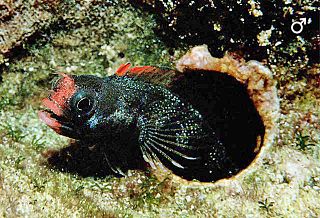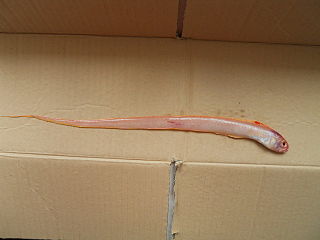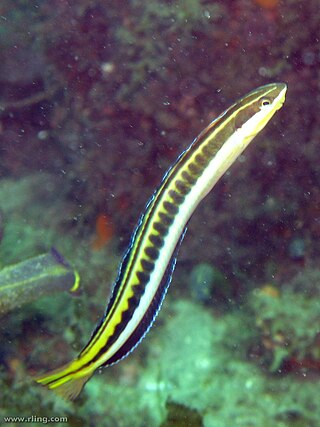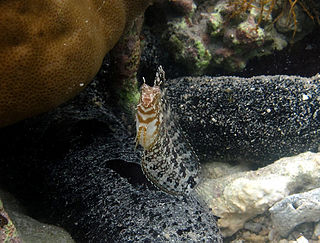
Combtooth blennies are blenniiformids; percomorph marine fish of the family Blenniidae, part of the order Blenniiformes. They are the largest family of blennies with around 401 known species in 58 genera. Combtooth blennies are found in tropical and subtropical waters in the Atlantic, Pacific and Indian Oceans; some species are also found in brackish and even freshwater environments.

The yellowhead jawfish is a species of jawfish native to coral reefs in the Caribbean Sea. It is found at depths of from 3 to 40 metres. The head and upper body are a light, but brilliant, yellow color slowly fading to a pearlescent blue hue. It can reach a length of 10 centimetres (3.9 in) TL. Yellowhead jawfishes are common in Florida. The Jawfishes live in rubble areas and sand in groups of up to 70 individuals.

The black swallower is a species of deep sea fish in the family Chiasmodontidae. It is known for its ability to swallow fish larger than itself.

Opistognathidae, the jawfishes, are a family of fishes which have been classified within the order Perciformes, suborder Percoidei but many authorities now classify this family within the clade Ovalentaria and consider that its affinities within that clade are uncertain, i.e. it is incertae sedis. The family includes about 80 species. They are native to warmer parts of the Atlantic, Pacific and Indian Oceans, where found from the shallows to depths of a few hundred meters. The species level taxonomy is complex and the family includes several undescribed species.

The cottonmouth jack is a gamefish in the family Carangidae. It was first described in 1860 by Cuban zoologist Felipe Poey in his two-volume work Historia Natural de la Isla de Cuba, or "Natural History of the Island of Cuba". It is also known as the cottonmouth trevally.

The mackerel scad, or speedo, is a species of fish of the family, Carangidae. While it can be considered gamefish, it is usually used as bait. It is popular for consumption in Hawaiʻi, the Philippines and the U.A.E. In Hawaiʻi, mackerel scad are called ʻopelu. In the Philippines they are called galunggong.
The dusky jawfish is a species of jawfish native to the western Atlantic Ocean including the Gulf of Mexico and the Caribbean Sea where it is an inhabitant of reefs at depths of from 1 to 12 metres. It can reach a length of 14 centimetres (5.5 in) TL. This species can also be found in the aquarium trade.

The moustache jawfish is a species of jawfish native to the western Atlantic Ocean where it occurs in the Gulf of Mexico and the Caribbean Sea. It is a reef inhabitant. This species can reach a length of 10 centimetres (3.9 in) TL. It can also be found in the aquarium trade.

The longfin crevalle jack is a recently described species of large marine fish classified in the jack family, Carangidae. It inhabits the subtropical waters of the east Atlantic Ocean, ranging along the African coast from Mauritania south at least to Moçamedes in southern Angola, with the species historically present in the Mediterranean Sea. It is an inshore species, known to occasionally penetrate estuaries, possibly to spawn. The species is very similar to the crevalle jack, Caranx hippos, and is separated by its extended dorsal and anal fin lobes as well as more detailed anatomical features including dorsal and anal fin ray counts. The fish is known to reach 127 cm in length and 20.9 kg in weight. The longfin crevalle jack is a predatory fish, taking small fish as its main prey. Due to longstanding confusion between C. fischeri and C. hippos, the importance of each species to African fisheries is poorly understood, with a known combined catch in this region of between 2,233 and 10,054 tonnes per year in 1995–2004. Like its close relatives, the species is considered a powerful gamefish and highly sought after, although their coarse flesh makes for relatively poor quality food.
Opistognathus is a genus of fish in the family Opistognathidae found in the Atlantic, Indian and Pacific Ocean.

Acanthemblemaria is a genus of chaenopsid blennies native to the Atlantic and Pacific Oceans.

Cepola is a genus of marine ray-finned fishes belonging to the bandfish family, Cepolidae. The name red bandfish is applied to all members of this genus, but particularly C. macrophthalma, and generally not C. australis, which is also known as the Australian bandfish.

Plagiotremus is a genus of combtooth blennies found throughout the Pacific and Indian oceans.

Meiacanthus is a genus of combtooth blennies found in the western Pacific and Indian oceans. Many species in this genus make their way into the aquarium trade and several are venomous. The genus name Meiacanthus is derived from the Greek meion meaning "less" and akantha meaning "thorn" and refers to most species having relatively few dorsal fin spines.

Petroscirtes is a genus of combtooth blennies found in the western Pacific, and Indian oceans. Some species of this genus have venom that interacts with opioid receptors. Adults usually inhabit coastal reefs and estuaries to depths of about 10 meters, but they can also be found up to 15 meters in depth in sandy and weedy areas among clumps of Sargassum or other seaweeds in coastal and lagoon reefs. They can be found in nests inside small-necked bottles and abandoned worm tubes or shells.

Chaenopsis is a genus of pikeblennies found in the Pacific and Atlantic oceans.

Dysomma is a genus of marine ray-finned fishes belonging to the family Synaphobranchidae, the cutthroat eels. These eels are found in the Atlantic, Indian and Pacific Oceans.
Owstonia is a genus of marine ray-finned fish belonging to the family Cepolidae, the bandfishes. It is the only genus in the monotypic subfamily Owstoninae. They are found in deep waters of the Indian and Pacific Ocean.

Lonchopisthus is a genus of jawfishes native to the tropical West Atlantic and East Pacific oceans.
The pygmy jawfish is a species of ray-finned fish from the family Opistognathidae, the jawfishes. It is the only member of the monospecific genus Anoptoplacus and the species and genus were described based on two specimens collected at depths of 240–260 metres (790–850 ft) at the Arrowsmith Bank off Yucatan, Mexico. As the name suggests, the pygmy jawfish is a very small species and many of its meristic characters are reduced compared to other jawfishes.















